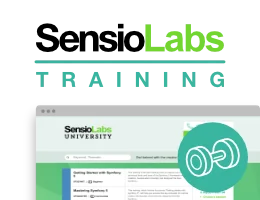Creating a custom Type Guesser
The Form component can guess the type and some options of a form field by using type guessers. The component already includes a type guesser using the assertions of the Validation component, but you can also add your own custom type guessers.
Form Type Guessers in the Bridges
Symfony also provides some form type guessers in the bridges:
- DoctrineOrmTypeGuesser provided by the Doctrine bridge.
Guessers are used only in the following cases:
- Using createForProperty() or createBuilderForProperty();
- Calling add() or create() or add() without an explicit type, in a context where the parent form has defined a data class.
Create a PHPDoc Type Guesser
In this section, you are going to build a guesser that reads information about fields from the PHPDoc of the properties. At first, you need to create a class which implements FormTypeGuesserInterface. This interface requires four methods:
- guessType()
- Tries to guess the type of a field;
- guessRequired()
- Tries to guess the value of the required option;
- guessMaxLength()
-
Tries to guess the value of the
maxlengthinput attribute; - guessPattern()
-
Tries to guess the value of the
patterninput attribute.
Start by creating the class and these methods. Next, you'll learn how to fill each in:
1 2 3 4 5 6 7 8 9 10 11 12 13 14 15 16 17 18 19 20 21 22 23 24 25
// src/Form/TypeGuesser/PhpDocTypeGuesser.php
namespace App\Form\TypeGuesser;
use Symfony\Component\Form\FormTypeGuesserInterface;
use Symfony\Component\Form\Guess\TypeGuess;
use Symfony\Component\Form\Guess\ValueGuess;
class PhpDocTypeGuesser implements FormTypeGuesserInterface
{
public function guessType(string $class, string $property): ?TypeGuess
{
}
public function guessRequired(string $class, string $property): ?ValueGuess
{
}
public function guessMaxLength(string $class, string $property): ?ValueGuess
{
}
public function guessPattern(string $class, string $property): ?ValueGuess
{
}
}Guessing the Type
When guessing a type, the method returns either an instance of TypeGuess or nothing, to determine that the type guesser cannot guess the type.
The TypeGuess constructor requires three options:
- The type name (one of the form types);
- Additional options (for instance, when the type is
entity, you also want to set theclassoption). If no options are guessed, this should be set to an empty array; - The confidence that the guessed type is correct. This can be one of the
constants of the Guess class:
LOW_CONFIDENCE,MEDIUM_CONFIDENCE,HIGH_CONFIDENCE,VERY_HIGH_CONFIDENCE. After all type guessers have been executed, the type with the highest confidence is used.
With this knowledge, you can implement the guessType() method of the
PhpDocTypeGuesser:
1 2 3 4 5 6 7 8 9 10 11 12 13 14 15 16 17 18 19 20 21 22 23 24 25 26 27 28 29 30 31 32 33 34 35 36 37 38 39 40 41 42 43 44 45 46 47 48 49 50 51 52
// src/Form/TypeGuesser/PhpDocTypeGuesser.php
namespace App\Form\TypeGuesser;
use Symfony\Component\Form\Extension\Core\Type\CheckboxType;
use Symfony\Component\Form\Extension\Core\Type\IntegerType;
use Symfony\Component\Form\Extension\Core\Type\NumberType;
use Symfony\Component\Form\Extension\Core\Type\TextType;
use Symfony\Component\Form\Guess\Guess;
use Symfony\Component\Form\Guess\TypeGuess;
class PhpDocTypeGuesser implements FormTypeGuesserInterface
{
public function guessType(string $class, string $property): ?TypeGuess
{
$annotations = $this->readPhpDocAnnotations($class, $property);
if (!isset($annotations['var'])) {
return null; // guess nothing if the @var annotation is not available
}
// otherwise, base the type on the @var annotation
return match($annotations['var']) {
// there is a high confidence that the type is text when
// @var string is used
'string' => new TypeGuess(TextType::class, [], Guess::HIGH_CONFIDENCE),
// integers can also be the id of an entity or a checkbox (0 or 1)
'int', 'integer' => new TypeGuess(IntegerType::class, [], Guess::MEDIUM_CONFIDENCE),
'float', 'double', 'real' => new TypeGuess(NumberType::class, [], Guess::MEDIUM_CONFIDENCE),
'boolean', 'bool' => new TypeGuess(CheckboxType::class, [], Guess::HIGH_CONFIDENCE),
// there is a very low confidence that this one is correct
default => new TypeGuess(TextType::class, [], Guess::LOW_CONFIDENCE)
};
}
protected function readPhpDocAnnotations(string $class, string $property): array
{
$reflectionProperty = new \ReflectionProperty($class, $property);
$phpdoc = $reflectionProperty->getDocComment();
// parse the $phpdoc into an array like:
// ['var' => 'string', 'since' => '1.0']
$phpdocTags = ...;
return $phpdocTags;
}
// ...
}This type guesser can now guess the field type for a property if it has PHPDoc!
Guessing Field Options
The other three methods (guessMaxLength(), guessRequired() and
guessPattern()) return a ValueGuess
instance with the value of the option. This constructor has 2 arguments:
- The value of the option;
- The confidence that the guessed value is correct (using the constants of the
Guessclass).
null is guessed when you believe the value of the option should not be
set.
Caution
You should be very careful using the guessMaxLength() method. When the
type is a float, you cannot determine a length (e.g. you want a float to be
less than 5, 5.512313 is not valid but
length(5.512314) > length(5) is, so the pattern will succeed). In this
case, the value should be set to null with a MEDIUM_CONFIDENCE.
Registering a Type Guesser
If you're using autowire and autoconfigure, you're done! Symfony already knows and is using your form type guesser.
If you're not using autowire and autoconfigure, register your service manually
and tag it with form.type_guesser:
1 2 3 4 5 6
# config/services.yaml
services:
# ...
App\Form\TypeGuesser\PhpDocTypeGuesser:
tags: [form.type_guesser]1 2 3 4 5 6 7 8 9 10 11 12 13
<!-- config/services.xml -->
<?xml version="1.0" encoding="UTF-8" ?>
<container xmlns="http://symfony.com/schema/dic/services"
xmlns:xsi="http://www.w3.org/2001/XMLSchema-instance"
xsi:schemaLocation="http://symfony.com/schema/dic/services
https://symfony.com/schema/dic/services/services-1.0.xsd">
<services>
<service id="App\Form\TypeGuesser\PhpDocTypeGuesser">
<tag name="form.type_guesser"/>
</service>
</services>
</container>1 2 3 4 5 6
// config/services.php
use App\Form\TypeGuesser\PhpDocTypeGuesser;
$container->register(PhpDocTypeGuesser::class)
->addTag('form.type_guesser')
;Registering a Type Guesser in the Component
If you're using the Form component standalone in your PHP project, use
addTypeGuesser() or
addTypeGuessers() of
the FormFactoryBuilder to register new type guessers:
1 2 3 4 5 6 7 8 9
use App\Form\TypeGuesser\PhpDocTypeGuesser;
use Symfony\Component\Form\Forms;
$formFactory = Forms::createFormFactoryBuilder()
// ...
->addTypeGuesser(new PhpDocTypeGuesser())
->getFormFactory();
// ...Tip
Run the following command to verify that the form type guesser was successfully registered in the application:
1
$ php bin/console debug:form
